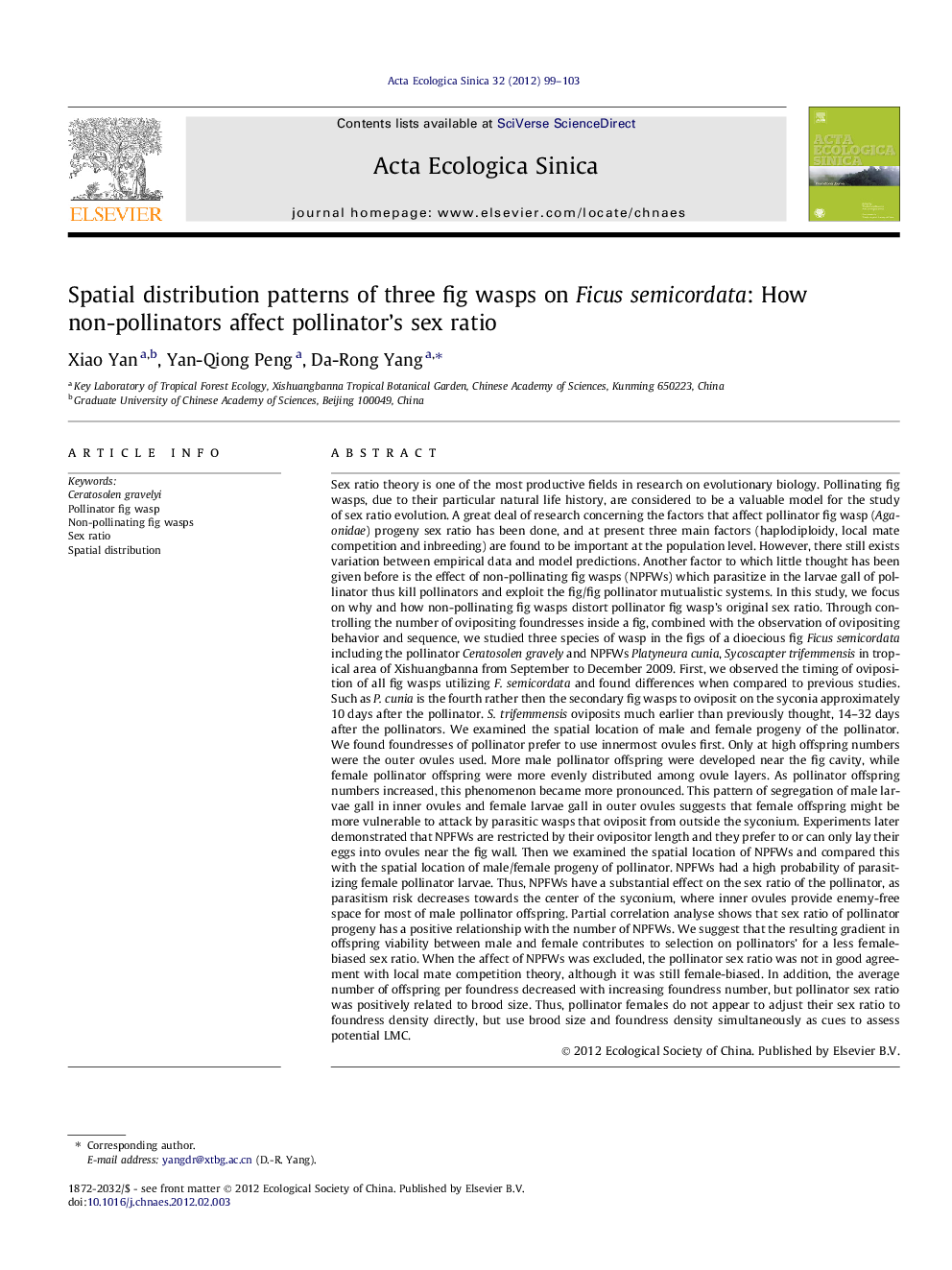| کد مقاله | کد نشریه | سال انتشار | مقاله انگلیسی | نسخه تمام متن |
|---|---|---|---|---|
| 4380000 | 1303957 | 2012 | 5 صفحه PDF | دانلود رایگان |

Sex ratio theory is one of the most productive fields in research on evolutionary biology. Pollinating fig wasps, due to their particular natural life history, are considered to be a valuable model for the study of sex ratio evolution. A great deal of research concerning the factors that affect pollinator fig wasp (Agaonidae) progeny sex ratio has been done, and at present three main factors (haplodiploidy, local mate competition and inbreeding) are found to be important at the population level. However, there still exists variation between empirical data and model predictions. Another factor to which little thought has been given before is the effect of non-pollinating fig wasps (NPFWs) which parasitize in the larvae gall of pollinator thus kill pollinators and exploit the fig/fig pollinator mutualistic systems. In this study, we focus on why and how non-pollinating fig wasps distort pollinator fig wasp’s original sex ratio. Through controlling the number of ovipositing foundresses inside a fig, combined with the observation of ovipositing behavior and sequence, we studied three species of wasp in the figs of a dioecious fig Ficus semicordata including the pollinator Ceratosolen gravely and NPFWs Platyneura cunia, Sycoscapter trifemmensis in tropical area of Xishuangbanna from September to December 2009. First, we observed the timing of oviposition of all fig wasps utilizing F. semicordata and found differences when compared to previous studies. Such as P. cunia is the fourth rather then the secondary fig wasps to oviposit on the syconia approximately 10 days after the pollinator. S. trifemmensis oviposits much earlier than previously thought, 14–32 days after the pollinators. We examined the spatial location of male and female progeny of the pollinator. We found foundresses of pollinator prefer to use innermost ovules first. Only at high offspring numbers were the outer ovules used. More male pollinator offspring were developed near the fig cavity, while female pollinator offspring were more evenly distributed among ovule layers. As pollinator offspring numbers increased, this phenomenon became more pronounced. This pattern of segregation of male larvae gall in inner ovules and female larvae gall in outer ovules suggests that female offspring might be more vulnerable to attack by parasitic wasps that oviposit from outside the syconium. Experiments later demonstrated that NPFWs are restricted by their ovipositor length and they prefer to or can only lay their eggs into ovules near the fig wall. Then we examined the spatial location of NPFWs and compared this with the spatial location of male/female progeny of pollinator. NPFWs had a high probability of parasitizing female pollinator larvae. Thus, NPFWs have a substantial effect on the sex ratio of the pollinator, as parasitism risk decreases towards the center of the syconium, where inner ovules provide enemy-free space for most of male pollinator offspring. Partial correlation analyse shows that sex ratio of pollinator progeny has a positive relationship with the number of NPFWs. We suggest that the resulting gradient in offspring viability between male and female contributes to selection on pollinators’ for a less female-biased sex ratio. When the affect of NPFWs was excluded, the pollinator sex ratio was not in good agreement with local mate competition theory, although it was still female-biased. In addition, the average number of offspring per foundress decreased with increasing foundress number, but pollinator sex ratio was positively related to brood size. Thus, pollinator females do not appear to adjust their sex ratio to foundress density directly, but use brood size and foundress density simultaneously as cues to assess potential LMC.
Journal: Acta Ecologica Sinica - Volume 32, Issue 2, April 2012, Pages 99–103